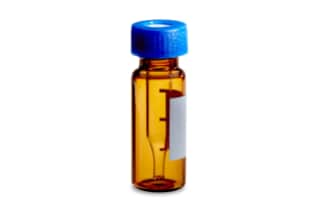
|
Certified |
LCGC Certified |
|
Closure Type |
Screw Neck |
|
Cap Color |
Blue |
|
Dimensions |
12 x 32 mm |
|
Format |
Qsert Vial |
|
Material |
Amber Glass |
|
Seal Material |
preslit PTFE/Silicone |
|
Volume Capacity |
300 |
|
Type |
Autosampler vial |
|
Includes |
Vial, Cap, & Septum |
|
Sample Limited |
Sample Limited |
|
UNSPSC |
41121806 |
|
Application |
Sample Preparation |
|
Product Type |
Vials |
|
Units per Package |
100 pk |

LCGC Certified Amber Glass 12 x 32 mm Screw Neck Vial, Qsert, with Cap and Preslit PTFE/Silicone Septum, 300 µL Volume, 100/pk
The LCGC Certified Amber Glass Screw Neck Vial comes with a Cap and Preslit PTFE/Silicone Septum that provides it an excellent sealing mechanism and holds all vial contents in place during processes and sample collections. Screwing the cap on applies a mechanical force that squeezes the septum between the glass rim and the cap creating a seal. The tight dimensional tolerances on all Waters vials and accessories make them ideal for use with virtually all HPLC systems.
Amber Glass vials offer your samples protection from any deterioration from exposure to UV light. The chemical inertness of the LCGC certified Amber Glass vial ensures that there is no interference with the analysis. All Waters LCGC Certified Vials are thoroughly UV-tested by HPLC, which detects even the smallest trace levels of chemicals used in the manufacturing and packaging processes. To give you peace of mind that you receive the cleanest equipment, Waters tests each batch of vials over a period of several days after the first to ensure there are no chemicals or external contaminants.
The PTFE/Silicone Septum is recommended for multiple injections and sample storage. It has demonstrated excellent resealing characteristics and chemical resistance until punctured. Once the seal has been punctured, the septum will have the chemical compatibility of silicone. The recommended working temperature range for the PTFE/Silicone Septum is from -40 ˚C to 200 ˚C, making it usable across a wide range of applications.
To learn more about the different types of vials available by Waters, such as the LCGC Certified Amber Glass vial with Screw Neck listed here, or to find different products that work with it or even to shop for lab equipment so you can replenish your stock and add to your existing equipment portfolio, you can browse our website and refer to our catalog.
You may want to look into Blue, 12 x 32 mm Screw Neck Cap and Preslit PTFE/Silicone Septum, 100/pk; which is compatible with a range of vials and other products. All Waters Screw caps are designed in consideration with other vial parts in order to achieve high-performance analytical instrumentation for chromatography.
What Is The Impact Of Color When Selecting A Vial?
Scientists have to consider many factors when selecting the best laboratory equipment, based on their labs’ needs and experiment requirements. This is especially true when selecting the best chromatography vial for specific scientific needs. Color is one of the important factors that comes into play as it determines the chemical stability of the compounds or extracts. Both glass and plastic vials are made in clear or amber colors by Waters. Depending on the composition of the contents collected, one may need to choose an amber vial to ensure protection from UV Light as it may damage certain chemicals. Amber vials are best suited for easily damaged chemicals, whereas Clear Vials provide scientists with the best visibility of chemicals.